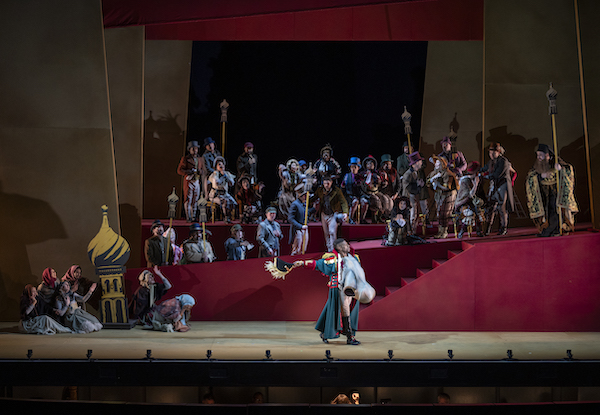COT sparks comic chaos with premiere of Shostakovich’s “The Nose”

Nothing says Christmas like an opera about a disembodied nose in Czarist Russia.
Chicago Opera Theater opened its production of Dmitri Shostakovich’s The Nose Friday night at the Harris Theater in what is the belated local premiere of the Russian composer’s 1928 comedy.
Adapted from Nikolai Gogol’s 1836 story, the scenario concerns one Palton Kuzmich Kovalyov, a hapless St. Petersburg bureaucrat who goes for a shave only to discover—oddly, after the fact—that the barber has inadvertently sliced off his proboscis. Kavalyov’s search for his missing member is complicated by the fact that his nose has taken on anthropomorphic ambitions and gained a ministry position as well as a higher social standing than its original owner.
Shostakovich’s The Nose is a work of its time and place, the composer caroming Gogol’s sly class criticism into a Soviet political template as a relentless operatic lampoon of bourgeois pretensions and social hierarchies.
The 22-year-old composer’s music for this satiric tale is aptly youthful and iconoclastic, cast in the kind of freewheeling, avant garde style of the era. The score mixes Russian folk tunes, frantic jazz, and atonal elements, with voices and instruments often pushed to cochlea-piercing extremes. Shostakovich jokingly leavens the musical anarchy with complex classical structures as in the double canon of the newspaper office scene where incongruous ads are sung by an eight-part chorus.
Despite receiving messianic encomia in some quarters, the fact is The Nose is pretty thin borscht. Inventive and audacious as the music sometimes is, the wide intervals, strident tones and shrieking shrillness quickly get hard on the ears. And for all its Dadaist absurdities and would-be madcap qualities, the opera itself is not all that funny.
Still, The Nose has significant historic freight, helping to plug a gap locally in our knowledge of Shostakovich’s musical development. With a worthy staging and a world-beater performance by Aleksey Bogdanov, Shostakovich aficionados should catch COT’s repeat on Sunday since this opera will not pass this way again anytime soon.

If the music gets wearying, COT’s new production, helmed by Francesca Zambello, does a commendable job with this intractable work by keeping the bizarro action moving at a frantic pace while deftly placing The Nose in its broader social, literary and historical contexts.
Erik Teague’s costumes for the principals largely adhere to the period of Gogol’s novel (with some satiric touches like the outside skirt hoops for the society matrons). The traditional element is nicely contrasted with the Soviet Futurist visuals of Marcus Doshi’s unit set—stark red and gray angled panels and a descending wall for a raised platform upstage. This clever production would likely travel well.
The forty-member cast for The Nose is huge by COT standards, with the 29 peripatetic ensemble members taking as many as four or five multiple roles.
Following up impressive COT turns in Rachmaninoff’s Aleko and Jake Heggie’s Moby-Dick, Aleksey Bogdanov delivered a star-making performance as the de-snouted protagonist Kovalyov.
Bogdanov was the embodiment of the beset and besieged Russian Everyman, angry and incredulous about the loss of his schnozzle. His mounting frustration with the crazed society around him and his unsuccessful repeated attempts to glue his detached nose back on provided the most hilarity of the evening.
Bogdanov is hardly offstage for a minute in this two-hour show and brought complete involvement to every moment whether singing, exploding in frustration or joyously dancing a Russian trepak when he and his nose are reunited. There aren’t many breakout aria moments in this opera but Bogdanov made the most of his opportunities, bringing his ripe and capacious baritone to Kovalyov’s lamentations.
Rarely does a title role have as little to do as the eponymous Nose in Shostakovich’s opera. The talented Curtis Bannister did what he could with the ungrateful comic part, which has little music to sing and consists mostly of walking around with a large nose on his chest.
The towering Wilbur Pauley got things off to a lively start, etching a nice cameo as the dissolute barber Ivan Yakolevich, who inadvertently hacks Kovalyov’s facial member to launch the proceedings. Michelle Johnson was an apt harridan as his nagging wife.
It was good to have David Cangelosi back on a Chicago opera stage, even in the small part of Ivan, Kovalyov’s lackey. Though much of the role was silent, Cangelosi let his bounteous character tenor ring out wonderfully in his balalaika song.
Samuel Weiser’s wry underplaying of four roles (Newspaper Clerk, Doctor, Con-Man and Khozrev-Mirza) made his quartet of characters genuinely humorous, standing out from the surrounding scenery mastication.
Tenor Justin Berkowitz was a dry-voiced Chief of Police with the punishing high tessitura of the comic role often rather approximate. Filling out the principal roles were Quinn Middleman as Countess Podtochina, Sam Grosby as Yaryzhkin and Evan Bravos as the Countess’s Lackey.
Boya Wei showed a rich and graceful voice in the arioso for Podtochina’s Daughter. Corinne Costell soared in the high soprano solo of the church scene, doubling as a comely Bagel Vendor.
Dancers inserted into an opera often prove an unwonted distraction but The Nose needs all the help it can get. Six members of the South Chicago Dance Theatre livened up the visuals with their energetic presence and Terpsichorean contributions to the frenetic action.
In her final appearance as COT music director, Lidiya Yankovskaya led a fizzing performance of Shostakovich’s irreverent score, drawing full-tilt playing from the hard-working orchestra. At times one wanted greater clarity and more balanced textures, especially in Shostakovich’s chaotic ensembles, but the conductor largely communicated the score’s musical audacity and pushed the piercing dynamic extremes.
The Nose runs again 3 p.m. Sunday. cot.org.

Posted in Performances


